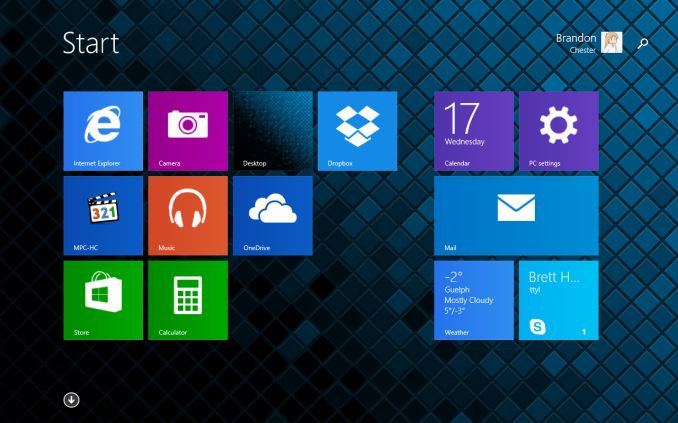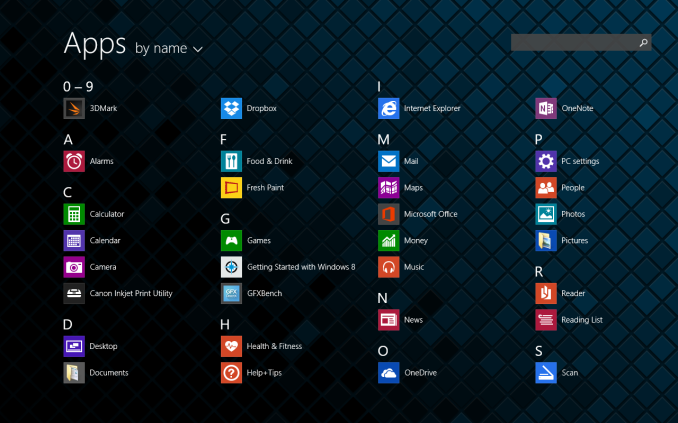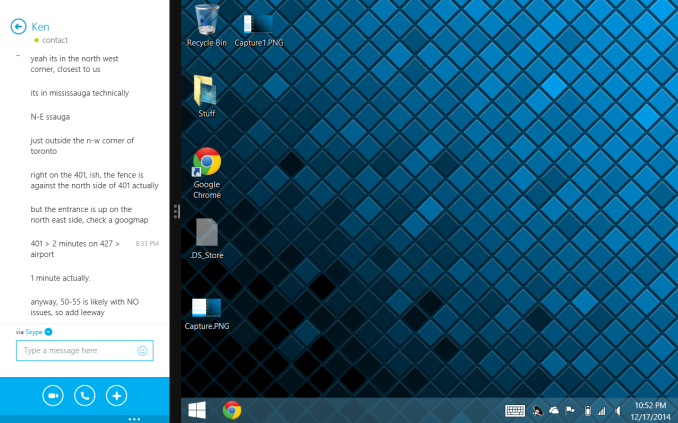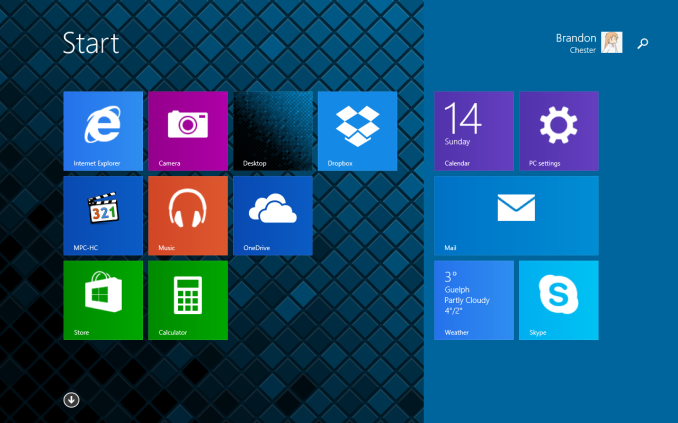HP Stream 7 Review: A $119 Windows Tablet
by Brandon Chester on December 19, 2014 8:00 AM ESTWindows On Tablets
It's sort of interesting how the Windows tablet experience is unknown to many people. I stated earlier that there's more of a focus on Android and iOS tablets than Windows ones. In fact, the Windows 8 experience in general is unknown to many people. Although Windows 8 was released over two years ago, it still hasn't gained significant adoption among Windows users, myself included. This means that the Stream 7 was actually my first real experience with Windows 8, used primarily with a touch interface and in the Modern UI.
Like many people, I don't feel that the Modern UI is well suited to desktops and laptops, and is aimed more at tablets. Since the Stream 7 is a tablet, I hoped that Windows 8 would be able to provide a good experience, as the alternative was accepting that Modern isn't really good on anything. The HP Stream 7 runs Windows 8.1, but I will refer to is simply as Windows 8 as 8.1 is a free upgrade much like service packs in older versions of Windows.
The Stream 7 can be used in both landscape and portrait orientations, and what's interesting is that unlike a 7" Android tablet where I feel compelled to use it in portrait mode, I prefer to use the Stream 7 in landscape. This may have something to do with Windows feeling more natural in landscape because of my experience using it on desktop and laptop computers that have widescreen monitors.
The big change for many users when going from Windows 7 to Windows 8 is the new full screen Start Screen that replaced the Start Menu from previous versions of Windows. The Start Screen is an area you will be spending a lot of time in when you use a Windows tablet. When you use Windows 8 on a traditional computer, many people use something like Start8 or Classic Shell to get back the old style Start Menu. Even if you aren't, you'll be spending a lot of time on the desktop. On tablets, the Start Screen is analogous to the home screen on iOS and Android, but it's more similar to Android's launcher implementation. It's a way to access all your full screen Modern UI applications, and so unlike a PC where you spend your time on the desktop, you spend your time on the Start Screen when you're not using an application on your Windows tablet.
Swiping down or tapping the arrow in the bottom left of the Start screen brings you to the Apps Screen. This is a list of every application on the device and it replaces the "All Programs" section of the old Start Menu. You can see most of the default applications above, along with a few that I've installed. Windows 8.1 seems to come with most of the applications that you would expect to have by default on a tablet, and it even has some like a Calculator that Apple hasn't thought to include on the iPad after six generations.
Some good news about bloatware is that when you purchase the Stream 7 from Microsoft's store there isn't really any. Windows Signature Edition doesn't come with any 30 day antivirus trials, or manufacturer software to do things that Windows already does. (This is a good thing, as running a bunch of extra software on a 1GB Windows tablet would be truly problematic.) There are a couple of applications from HP relating to support documentation and registering your warranty, but these can be deleted and they only take up a few hundred megabytes. On that note, the Stream 7 comes with a bit under 19GB free out of the box, and I'll talk about storage management in a moment.
I think the split screen feature is an area where Microsoft is ahead of the competition by a large margin. The iPad has nothing that compares to this, and the multi-window support on some of Samsung's tablets is not implemented as well. Microsoft allows you to place two apps side by side, and the size of each can be adjusted by moving the bar that separates them. You can even put Modern UI applications next to the Windows desktop, which is a neat feature that you can see demonstrated above.
I think the implementation is a bit unintuitive though. To access it, you need to open your open applications by dragging in from the left, and then dragging back. This is a horrible gesture, because it's swiping somewhere and then reversing it, which would imply that the result is no change at all. Once you figure that out, you then drag your second application from the list and place it next to the one you currently have open. When you get the hang of it, it becomes very easy, but when I was first getting used to the tablet I found myself doing it by accident.
Unfortunately, the experience isn't without its issues. One of the things I've found difficult is managing storage. On an iOS or Android device, most of your files are stored within an application's container, so it's easy to manage storage by simply looking at how much space applications and their documents are taking up. Windows is more complicated, as it's a complete desktop operating system with a file system that users are intended to interact directly with on a regular basis.
When I add up all the space taken up by applications, documents, etc. in the storage section of the settings app, there is still space that is being used that I cannot easily trace. It can be difficult to keep track of every saved photo, video, document, etc. when they're not all forced into a specific application's storage location, and I suspect there are also hidden folders like Appdata with files taking up space from applications I have uninstalled. This problem applies more to desktop Windows applications than Modern UI ones, but it's worth noting because I think other users will end up having to deal with this as well.
I've also encountered a few annoying software issues. One that occasionally pops up is what you see above, where there seems to be some issue with rotating my wallpaper that leads to a large area that matches the accent color I've chosen. I've tried to fix this by using different wallpaper dimensions, such as a native 1280x800 image, and a 1280x1280 image that should fit along the tablet's longest axis in any orientation, but it still seems to occur. Simply resetting the wallpaper or rebooting usually fixes the problem but it's worth pointing out. There are also times where applications or the interface itself will stop responding, which can be frustrating; it can be a painful reminder that you're running Windows.
As for the applications on the Windows Store, the experience ranges from good to really, really bad. Most of Microsoft's applications are very good, as expected. There are also third party apps like Dropbox that are just as good as on other platforms. But those seem to be exceptions to what I see as the theme in the Windows Store where applications fit into one of three categories:
- The app you want doesn't exist at all, with no first or third-party option.
- A first-party app exists, but it's either outdated compared to other platforms or just not as good.
- A third-party app exists, but it's missing features or doesn't perform well.
This is a serious issue, and at this point I honestly don't know how Microsoft can resolve it apart from trying to bribe developers. Twitter is a great example of an application that exists but is not as good as the version on iPad by any measure. I can't fault HP or the Stream 7 for this, but it is running Windows and it's a problem that will affect them even more than it affects Microsoft.
While there are tons of legacy Windows applications out there, the touch experience in the traditional Windows desktop interface is not very good. I find things difficult to tap, it's hard to fit Windows on the screen, and applications simply don't look or run as well as Modern UI ones.
This brings us to a very confusing situation regarding Microsoft Office. The Stream 7 includes 1 year of Office 365 with one PC license, one tablet license, and one smartphone license. The problem is, Microsoft doesn't have a touch optimized version of Office for Windows like they do for the iPad. Unless you hook up a Bluetooth mouse and keyboard, it's really hard to use the desktop Office client on a Windows tablet.
To me, this represents an oversight in Microsoft's product planning. The iPad is by far the dominant tablet in terms of usage share, and so it would make sense to target it due to the potential customers available. However, it means that Microsoft has prioritized another platform over their own. This does absolutely nothing to help the troubles that Windows 8 is facing. If Microsoft isn't going to make their own platform a priority, how can developers be expected to do so? Similarly, if Microsoft isn't going to support their platform, why should customers adopt it? By the time Windows 10 rolls around, Microsoft needs to improve the touch experience in the Windows desktop interface, and they need to make a touch optimized version of Office for the Modern interface.
Overall, Windows on tablets is something of a mixed bag. The interface translates better from PCs to tablets than I expected, and there are some well implemented features like split-screen multitasking, but there's still a lot of work to be done. Microsoft needs to improve the application selection quickly, and improved touch support definitely needs to be a priority.














157 Comments
View All Comments
lazymangaka - Sunday, December 21, 2014 - link
I wonder if the headphone static is a problem with the Bay Trail chips or something weird with this zero cost version of Windows, because my Acer Iconia W4-820 also suffers from an annoyingly large amount of static over its 3.5mm headphone jack.Regular Reader - Monday, December 22, 2014 - link
Interesting. I have an Iconia W4 and haven't noticed the static. Does it happen to you at any volume level?AllanMoore - Monday, December 22, 2014 - link
If you live close to a MicroCenter, a much better pick would be the Winbook TW800 ($ 100). It's got a full USB 3.0, hdmi, micro sd, ips. In my opinion, it's by far the best $ 100 out there. Otherwise i would add extra $49 and buy <a href="http://www.amazon.com/gp/product/B009X3UW2G?ie=UTF... Asus Nexus 7</a>. It's faster and better value!ados_cz - Monday, December 22, 2014 - link
Whether it is a better value depends on user, I prefer the full windows 8.1 on my Linx 7, bookmark bar in IE synchronizes with my desktop pc as well as bunch of other things. It is just nice to have a proper PC in pocketable form factor. I have even found a very nice touch screen touchpad in windows store for mouse cursor navigation, handy when you connect external screen and extend the desktop. I just really love this cheap windows tablet. Linx 7 is sooo nice, 280g of full PC experience goodness :-) I have even sold my very good touchscreen Dell e5440 because it became obsolete to me, still keeping hi end mini itx desktop.harrynsally - Monday, December 22, 2014 - link
With HDMI and full size USB, I thought of getting one of these to use with external monitor and wireless keyboard/mouse.At $100, the TW800 WinBook only has 1GB RAM and 16GB eMCC storage. Even after tuning, Win 8.1 will use 95% of the storage and adding microSD only good for saving photos, documents.
For $200, you can get the TW100 WinBook that comes with 2GB RAM and 32GB eMCC storage, which will allow room to run additional software.
Did my homework and just purchased a Dell Inspiration NoteBook for $300. that included a Haswell i3 processor, 15.6" touch screen, 4GB RAM, 500GB storage, HDMI, 3 USB ports including one 3.0), optical DVD drive, 4 cell battery etc.
marvdmartian - Monday, December 22, 2014 - link
Bought one of these on BF, on sale from Office Depot for $79. Tried it for a few weeks, and I'm shipping it back to them today.Frankly, I was underwhelmed with it. As pointed out in the review, battery life is dismal.....even when it's on standby! While I wasn't using it every day, I did try to pick it up whenever possible, to attempt to immerse myself in the Windows 8 experience, as this was my first W8 device. But it seemed as though every time I picked it up to use it, I had to plug it in and charge it first! Sorry, but sitting there, doing NOTHING for 3 days, and the battery dies (from WHAT??) is NOT acceptable to me.
As I already said, this was my first W8 device.....and will likely be my last one, too. I know, I know, some people are enamored with it, and think it's the greatest thing since sliced bread. But I'm just not impressed with it (and this is the improved Windows 8?? yikes!). I have used pretty much every version of Windows since 95, and found this one to be the least intuitive one of all. Hopefully Windows 10 will bring back some of the simplicity of the older versions!
As I said, this is being shipped back today. I did a refresh of the operating system (to wipe my info off of it), boxed it up, and Office Depot is paying the return shipping. In its place, I'm looking at the year old Asus 7" tablets, running Android. I've owned one of the newer 10" tablets made by them for almost a year now, and have been much more impressed with their products, as well as their value, than any other manufacturer out there.
kg4icg - Monday, December 22, 2014 - link
I actually have this tablet, been using it for a couple of weeks now. Not bad at all,, Have a 64gb Samsung SXDC UHS-1 card in it. Actually use it to program radios in the field by way of USB-OTG adapter. Use my phone as a hotspot whenever I need to do something online. Not bad for something I picked up from Microsoft for $100. Oh by the way, I'm posting this comment thru it.kg4icg - Monday, December 22, 2014 - link
By the way, only the Back cover is plastic, the frame is metal, possibly aluminum. A Plastic tablet this size is half the weight, Namely the Samsung Tab 4.BuddyRich - Monday, December 22, 2014 - link
I recently bought a DVP8 on-sale (wanted more RAM) but considered the Stream 7.I justified it as a Raspberry Pi with a built-in screen. I mean outfitted with a case you are spending $35 to 45 for that Pi Whats another $50-60 for a multi-touch screen if you have a use for it? If you don't, obviously don't spend on it. I bought it to be a replacement for a squeezebox touch, which this does superbly.
It comes with a Windows License which is handy, you can still get Linux on it if you want the lighter-weight OS... I think the UX is rough using desktop Windows with touch. They really should have put the keyboard on the charms bar rather than taskbar as you'll be using it alot if you don't use a bluetooth keyboard.
My only complaint is the OS is not a "pro" license so I had to use Team Viewer rather RDP to connect to my device.
Wolfpup - Tuesday, December 23, 2014 - link
So glad you guys reviewed this! Very disappointing that the headphone jack is bad. Everything else seems...well, not bad or even good for a $100 tablet, but not being able to use this for media, when otherwise it would be AWESOME for media since it's real Windows kind of kills it for me.Meanwhile I think it was Toshiba has a cheap 7" one too but it's killed by using a 1024x800 (?) screen with a higher resolution scaled down to it. Seems like it both cases spending the extra $60 or whatever for the 8" tablets would be the way to go (assuming the 8" models don't have these problems).
Worth noting that actually the Windows desktop is VERY useable on a 10.6" screen...it even works pretty well through my iPad's 9.7" screen with remote desktop. (The issues there are more just that there's a bit of lag/weirdness since it's sending touch commands across a wifi network!)